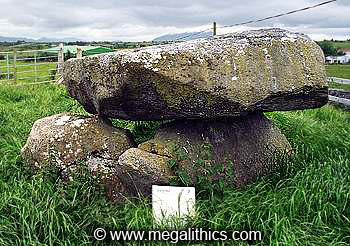
 |
Photo Gallery |
|
Panoramas |
||
| G 23796 18175 (GPS 10min. roofstone). | |
| Visited June 2002 |
The Dolmen of the Four Maols stands on the outskirts of Ballina about 400m SW of a railway station and just to the east of an old lane known as Cockle Street. After visiting so many Irish megalithic sites in the countryside, the suburban setting of this tomb seemed strangely incongruous to us. Although the rise that the tomb is built on is quite low, it is the highest point for some kilometres, so the site enjoys panoramic views in all directions. The Moy River lies less than a kilometre to the east and would probably have been visible from the site before Ballina town intervened.
The tomb has been extensively savaged over the ages and so little remains today that even a classification of its original type is not possible. The main surviving element has two sidestones and a backstone with heights ranging from 0.75m to 1.1m, all supporting a large roofslab which is about 0.6m thick. The only other survivor is a large loose stone 4m away at the SSE. The structure is probably the rear chamber or gallery section of an originally more elaborate tomb, which seems to have had a N-S main axis. It seems that someone in the past had a penchant for attaching plaques or notices to the roofstone and as a consequence it bears two hexagonal arrays of deep drill holes on its west and NE edges.
There is a plaque at the site today, but this is thankfully incorporated into the retaining wall at the roadside, and not actually screwed to the stones themselves. The plaque tells of a legend associated with the Dolmen.
The man on the throne of Connaght was called Guaire Aidhne, but the rightful heir was a man called Ceallach. Ceallach had renounced worldly affairs and eventually became the bishop of Kilmoremoy, which is known today as Ballina. The four brothers of Guaire, the Four Maols, were being taught by Ceallach when they murdered him, they were tried for the offence and sentenced to death. The brothers were taken to Ardnariogh, the Hill of Execution , Ardnariogh is called Ardnaree today, it lies east of the Dolmen across the Moy River. After the Maols were hanged, their bodies were carried through a secret tunnel running under the River Moy and buried at Primrose Hill under the Dolmen that bears their name.
We're pretty sure that the timeframe for the above story is at least two thousand years too late to account for the construction of the tomb, but it's a cracking yarn nonetheless.